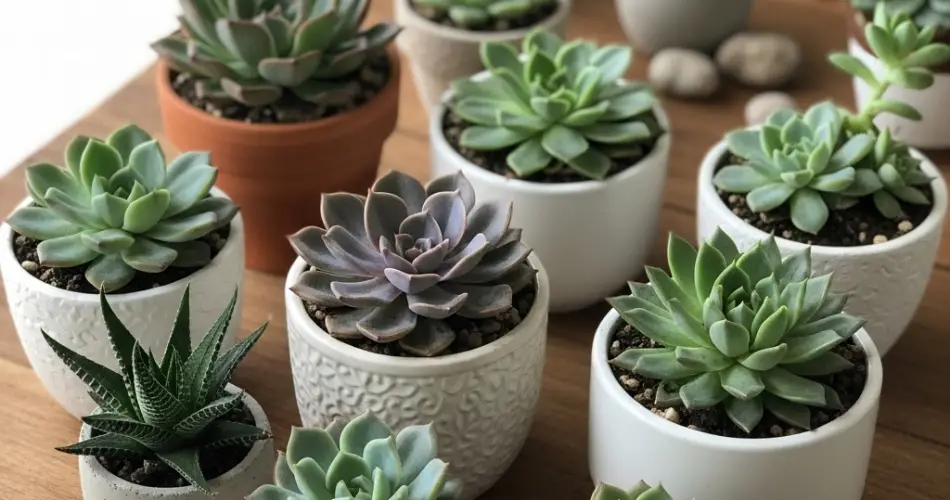Succulents are beloved for their striking shapes, vibrant colors, and resilience. Known for their ability to store water in thick leaves, stems, or roots, they are perfect for busy plant enthusiasts or anyone looking for low-maintenance greenery. Despite their hardiness, succulents still require understanding and attention to certain key aspects—light, soil, water, and occasional care—to thrive indoors or outdoors. This guide provides practical tips for keeping succulents healthy, vibrant, and growing, even with minimal effort.
Choosing the Right Succulent
The first step to successful succulent care is selecting the right plant for your space and environment. Some popular low-maintenance varieties include:
-
Echeveria: Known for rosette-shaped leaves and vibrant colors.
-
Haworthia: Small, slow-growing, and tolerant of lower light.
-
Jade Plant (Crassula ovata): Hardy with a tree-like appearance.
-
Sedum: Offers trailing growth, ideal for containers or hanging arrangements.
Consider the lighting and climate conditions of your space. Succulents generally prefer bright, indirect light, though some varieties tolerate lower light levels better than others.
Soil Matters
Succulents thrive in soil that drains quickly, preventing water from pooling around the roots. Key soil tips include:
-
Well-draining mix: Use a commercial cactus or succulent mix, or create your own by combining regular potting soil with sand, perlite, or pumice.
-
Pot selection: Ensure containers have drainage holes. Excess water can cause root rot and stunt growth.
-
Avoid compacted soil: Dense soil retains too much moisture, so aerated, loose soil is ideal.
Healthy soil creates a strong foundation for succulent roots, allowing them to store water efficiently and grow steadily.
Watering the Minimalist Way
Watering is one of the most critical factors for succulent health. Their water-storing ability allows them to survive infrequent watering, but improper watering is a leading cause of plant stress.
-
Check soil before watering: Only water when the soil is completely dry. Stick your finger an inch or two into the soil to test moisture.
-
Water deeply, infrequently: When watering, soak the soil until water drains from the bottom. This encourages deep root growth.
-
Seasonal adjustments: Water more during active growth (spring and summer) and reduce watering in fall and winter when growth slows.
-
Avoid misting leaves: Excess surface moisture can lead to rot and fungal issues. Focus on the soil.
Minimal watering, combined with proper soil, allows succulents to thrive without daily attention.
Light and Temperature
Light is essential for succulent health and vibrant leaf color:
-
Bright, indirect sunlight: Most succulents do well near a south- or east-facing window.
-
Direct sun caution: Some varieties tolerate direct sunlight, but too much can scorch leaves. Gradually acclimate plants to full sun.
-
Temperature: Ideal indoor temperatures range from 60–80°F (15–27°C). Protect succulents from frost and cold drafts.
Providing appropriate light and temperature conditions helps succulents grow compact, colorful, and strong.
Minimal Maintenance Tips
Even low-maintenance succulents benefit from occasional attention:
-
Remove dead leaves: Trim yellowing or dried leaves to prevent pests and improve appearance.
-
Fertilize sparingly: Use a balanced, diluted fertilizer once or twice during the growing season. Too much fertilizer can cause leggy growth.
-
Repot when necessary: Refresh soil every 1–2 years or when the plant outgrows its container.
These small steps keep succulents healthy without requiring intensive care routines.
Signs of Stress to Watch For
Even hardy succulents show signs when conditions aren’t ideal:
-
Wrinkled leaves: Usually a sign of underwatering.
-
Soft, mushy leaves: Overwatering or root rot.
-
Discoloration or stretching: Indicates insufficient light.
Early detection allows you to adjust care and prevent long-term damage.
Conclusion
Succulents are ideal for those seeking beautiful, low-maintenance greenery. By choosing the right variety, using well-draining soil, watering minimally, providing adequate light, and performing occasional maintenance, even busy gardeners can enjoy thriving succulents. Their natural resilience, combined with these simple care strategies, ensures vibrant growth and longevity.
Understanding the essentials of soil, water, and light allows succulents to flourish with minimal effort, making them perfect companions for indoor spaces, patios, and low-fuss gardens. With these techniques, your succulents will reward you with enduring beauty, color, and texture year-round.



